The Rise of the Religious Right in the Republican Party
Home Page
Introduction
Government
Environment
Judiciary
Scalia
Federalist Society
Bush
Faith Base Initiative
Dominion Economics
Schools and Homophobia
Religious Institutions
Middle East
The Media
Satan
States' Rights
Separation of Church and State
Appeal of the Religious Right
2002 Texas GOP Platform
Biography of Joan Bokaer
Last Update July, 2003
In this section:
Core Values
War on Nature
Christian Coalition Scorecards Compared to Environmental Scorecards
Chair of the Committee on the Environment and Public Works: Senator James Inhofe
Core Values
The Bush administration is waging a virtual war on the environment enabling industries to decimate forests, divert water, pollute national parks, and release CO2 and toxins into the atmosphere.
This disregard for the environment reflects core values of the Religious Right, a movement strongly allied with big corporations. The Texas Republican Party Platform, 2002, opposes efforts to regulate industry by affirming a belief in "a strong and vibrant private sector unencumbered by excessive government regulation." It calls for abolishing the Environmental Protection Agency, and reaffirms "the belief in the fundamental right of an individual to use property without governmental interference.."
An impending sense of "end times" is good news for that portion of the Religious Right that sees destruction of the earth as leading to the Second Coming of Jesus Christ and 1,000 years of earthly paradise. Those who don't seek "end times," blame resource depletion on environmentalists who view natural resources as limited. Secular society "lack(s) faith in God's providence and consequently, men will find fewer resources... The Christian knows that the potential in God is unlimited and that there is no shortage of resources in God's earth." (America's Providential History.)
Not all Evangelicals support the political agenda of the Religious Right. For example, the Evangelical Environmental Network's Declaration on the Care of Creation assumes responsiblity to protect and restore the environment. "Because we have sinned, we have failed in our stewardship of creation. Therefore we repent of the way we have polluted, distorted, or destroyed so much of the Creator's work." Click Here.
War On Nature
Air, Water, Land, Energy and the Global Climate: Bush's Stamp
"For two years, it has come in bursts, on issues from arsenic to wetlands: the unfolding of what President Bush, as a candidate, promised would be a new era of environmental protection. Whether rejecting a treaty on global warming, questioning Clinton-era rules on forest protection or pressing for changes in landmark environmental laws, Mr. Bush has imposed a distinctive stamp on a vast landscape of issues affecting air, water, land, energy and the global climate. The New York Times, February 23. Click Here.
Healthy Forest Initiative
The cartoon strip, "Boondocks," September 9, 2003, captures the spirit of Bush's Healthy Forest Initiative .
Huey is listening to the TV news.
BOX 1: "And now we go live to the southwest where President Bush is talking
about his environmental policy."
BOX 2: "Ladies and gentlement -- America can no longer turn a blind eye to a terrible enemy that lives among us.
An enemy that has betrayed and scarred us as a country."
BOX 3: "Trees -- nature's terrorists."
Defenders of Wildlife call Bush's Healthy Forest Initiative a plan that "comes straight from corporate timber interests, which have yet to encounter a question to which more logging isnít the answer." Click Here.
"[In] the so-called forest stewardship program, ... timber companies are allowed to harvest trees as payment in kind for other projects like road clearing or the thinning of underbrush to prevent forest fires. Conservationists fear that open-ended, broadly drawn stewardship contracts will give the loggers license to cut huge tracts that would otherwise be spared."New York Times Editorial, February 12, 2003, discusses a Senate-House appropriations bill loaded with destructive anti-environmental riders. Click Here.
Clear Skies
The New York Times calls Bush's clear air initiative, a "reckless and insupportable decision to eviscerate a central provision of the Clean Air Act and allow power plants, refineries and other industrial sites to spew millions of tons of unhealthy pollutants into the air."Click Here.
"Bush Administration to Gut Clean Air Act. Rule Would Allow More Pollution at 17,000 Facilities," claims the Natural Resources Defense Council. Click Here.
The following press release from the Natural Resources Defenses Council criticizes the Bush administration for joining with Detroit to fight California's zero emissions vehicle. The "federal government's siding with Detroit is an unprecedented attack on California's legal right to regulate air pollution." Click Here.
Undermining Environmental Law
"On issues large and small, the Bush administration has spent the better part of two years rolling back Bill Clinton's environmental legacy. It has abandoned the Kyoto accord on global warming, weakened protections for wetlands and eased mining laws.
"Now it appears to be aiming at even bigger game - the National Environmental Policy Act, regarded as the Magna Carta of environmental protection and perhaps the most important of all the environmental statutes signed into law by Richard Nixon three decades ago." NY Times Editorial, September 30, 2002, "Undermining Environmental Law," Click Here.
Undermining The Montreal Protocol to Protect the Ozone Layer
On February 7, the Bush administration sought an exemption to a ban on methyl bromide, a chemical that harms the ozone layer. He is now instituting that ban, threatening to unravel the Montreal Protocal to protect the ozone layer, the most successful treaty in the history of the environmental movement. Environmental writer, Glen Scherer, has writter an article in Salon on this important decision. Click Here.
Wetlands Protection Fades By
The New York Times, February 11, 2003, claims that for the past two years the Army Corps of Engineers has been undergoing a "broad retreat" in the amount of wetlands it protects. Click Here.
"Here's why the environmental community isn't ecstatic over President Bush's call to spend more than $1 billion over five years to develop a hydrogen-powered car to wean us from our addiction to Middle East oil." Robert Kennedy Jr. discusses problems with Bush's proposal for fuel cell cars in this New York Times Op-ed, February 16, 2003. Click Here.
The White House is proposing that the military be exempt from environmental regulations, reported in New York Times, February 6, 2003. Click Here.
Christian Coalition Scorecards compared to Environmental Scorecards
The League of Conservation Voters (LCV) publishes a National Environmental Scorecard. The Scorecard provides objective, factual information about the environmental voting records of U.S. Representatives and Senators. Click Here. The higher the rating from Religious Right groups, the lower the rating from the League of Conservation Voters.
The following graphs compare how Christian Coalition and the League of Conservation Voters(LCV) rated Congress in 2001. Republicans are red, Democrats blue. LCV is made up of several environmental groups.

|
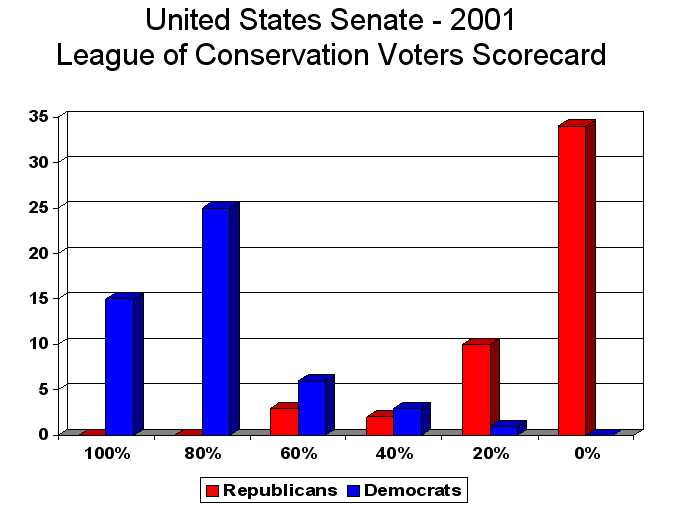 |
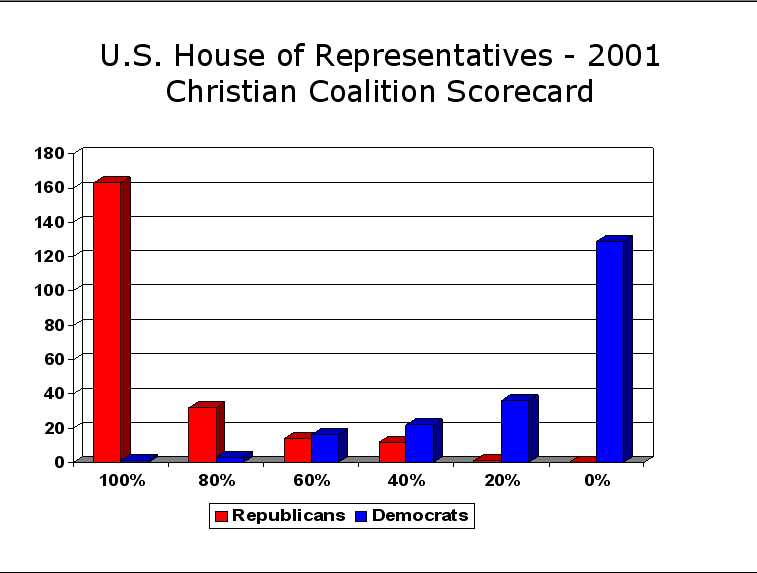 |
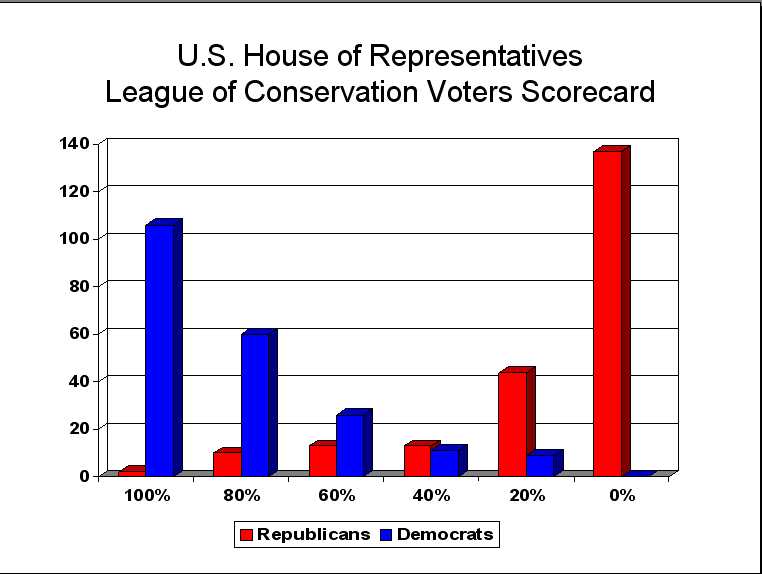 |
The third graph shows how the Christian Coalition rated members of the U.S. House of Representatives: 100% -- 163 Republicans, 1 Democrat. 80% -- 32 Republicans, 3 Democrats. 60% -- 16 Republicans, 14 Democrats. 40% -- 12 Republicans, 22 Democrats. 20% -- 1 Republican, 36 Democrats. 0% -- 0 Republicans, 129 Democrats.
The fourth graph shows how the League of Conservation Voters rated members of the U.S. House of Representatives. 100% -- 2 Republicans, 106 Democrats. 80% -- 10 Republicans, 60 Democrats. 60% -- 13 Republicans, 26 Democrats. 40% -- 13 Republicans, 11 Democrats. 20% -- 44 Republicans, 9 Democrats. 0% -- 137 Republicans, 0 Democrats.
Leadership of U.S. Congress
The following two tables compare the ratings of Congressinal leadership from the Christian Coalition and the League of Conservation Voters in 2003. The table on the left is the U.S. House of Representatives. The table on the right is the U.S. Senate. CC stands for the Christian Coalition, and LCV stands for the League of Conservation Voters.

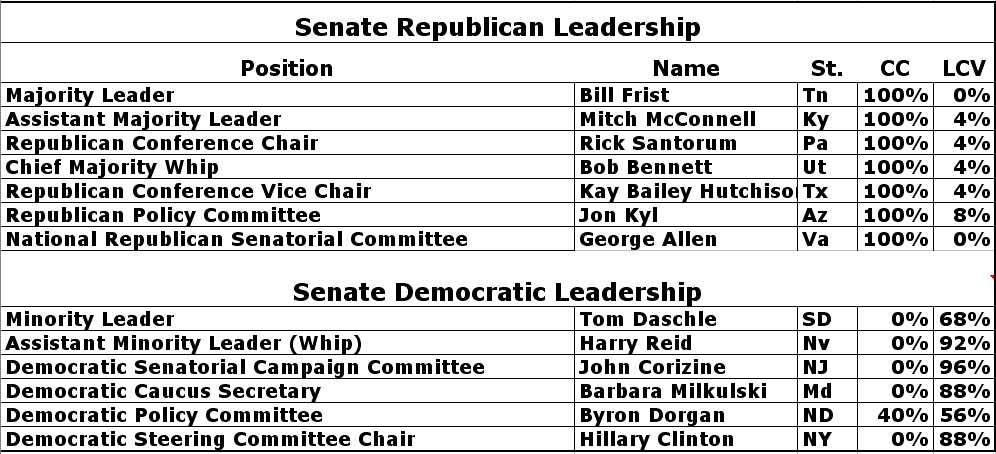
Whichever party holds a majority also holds the leadership positions. They decide what bills will and won't come up for a vote, and they chair the committees which play an important role in setting the agendas. With one exception, top ranking Republican leaders of both the U.S. House of Representatives and the U.S. Senate in the 108th Congress have received very high ratings from the Christian Coalition and very low ratings from the League of Conservation Voters. The inverse is true for Democratic leadership. Glen Scherer, an environmental writer, compared the scorecards for the 2003 Congressional leadership from both Christian Coalition (CC)and League of Conservation Voters (LCV):
Chair of the Committee on the Environment and Public Works: Senator James Inhofe
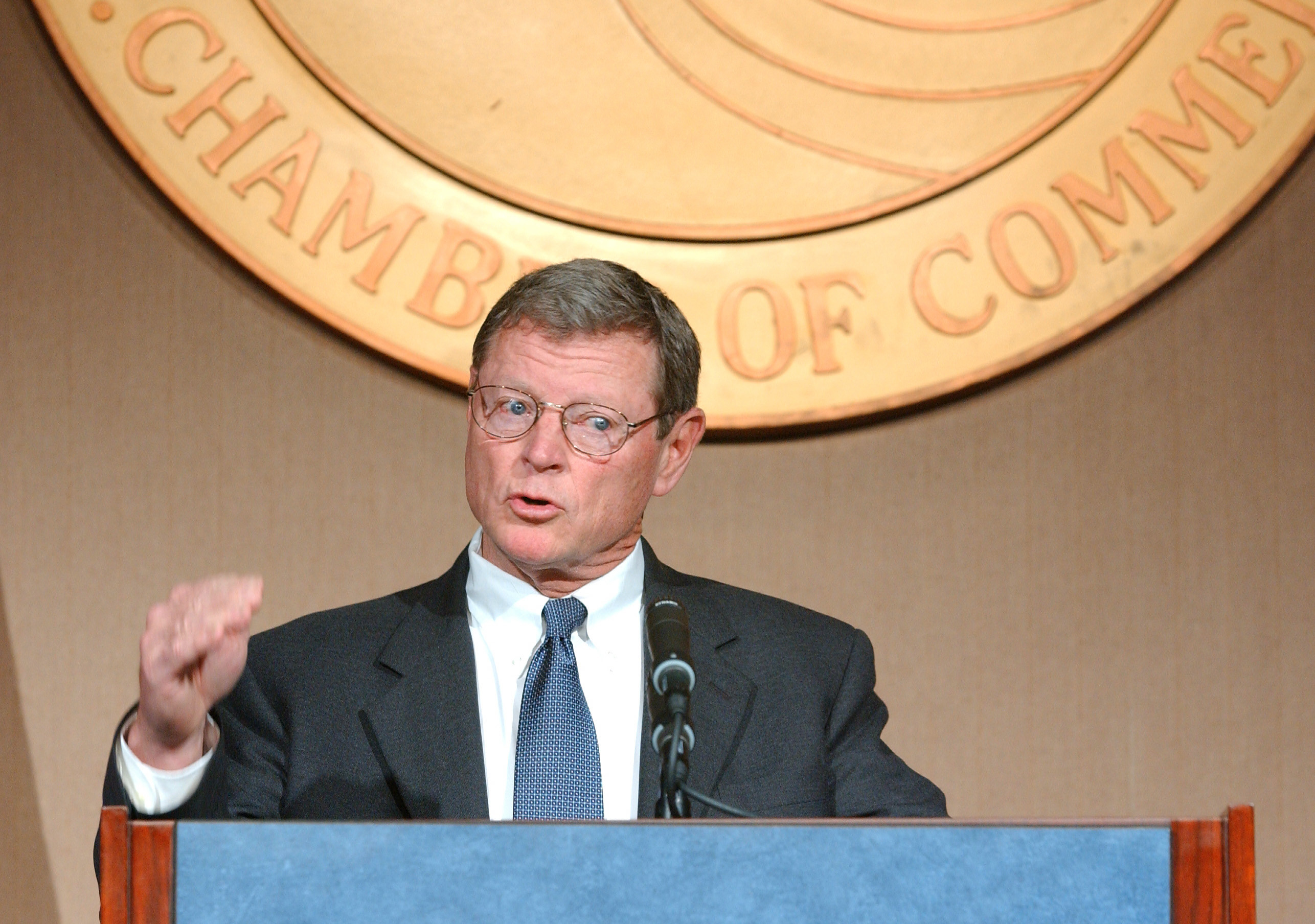 U.S. Senator James Inhofe, (R-Okla) who said at the 2002 Christian Coalition Road to
Victory gathering, "Get the few liberals out!
You will be doing the Lord's work, and
He will richly bless you for it," is a favorite of the coal and oil industries. As
chair of the Committee on the Environment and Public Works, he has appointed a coal
mining lobbyist to oversee clean air legislation..
Click Here.
U.S. Senator James Inhofe, (R-Okla) who said at the 2002 Christian Coalition Road to
Victory gathering, "Get the few liberals out!
You will be doing the Lord's work, and
He will richly bless you for it," is a favorite of the coal and oil industries. As
chair of the Committee on the Environment and Public Works, he has appointed a coal
mining lobbyist to oversee clean air legislation..
Click Here.
While Europe is sweltering in record-breaking heat, Inhofe made an impassioned two-hour speech on global warming. On July 28, 2003, he said, "With all of the hysteria, all of the fear, all of the phony science, could it be that man-made global warming is the greatest hoax ever perpetrated on the American people?"
Just 25 days earlier, a stunning report was issued by the World Meteorological Organization, an "impeccably respected UN organization that is not given to hyperbole" (Independent,7/3/03). The British newspaper continues, "In an astonishing announcement on global warming and extreme weather, the World Meteorological Organization signalled last night that the world's weather is going haywire." The report cites as an example the 562 tornadoes that hit parts of the United States in just one month -- last May.
The New York Times reported that Inhofe convened a hearing on global warming that included only that "small core of researchers who insist there's no evidence for human-centered warming of any sort." (8/4/03) The Times then quoted Dr. Rogers A. Philips, director of the Center for Science and Technology Research at the University of California, noting "We are on the brink of having Republican science and Democrat science." Environmental writer, Glenn Scherer has written two articles for Salon.com. on politics and the environment. The first article: "A bipartisan group of Northeastern governors is expected to announce an historic agreement this week to reduce carbon dioxide emissions from power plants, a plan that would break sharply with Bush administration policy on global warming." Click Here The following article, "George W. Bush's War on Nature" warns of the danger of trusting ideology over science. "Republicans are pushing the most radical assault on the environment in modern times. But history warns of catastrophe for leaders who trust ideology over science." Click Here| Next Page |
| Home |